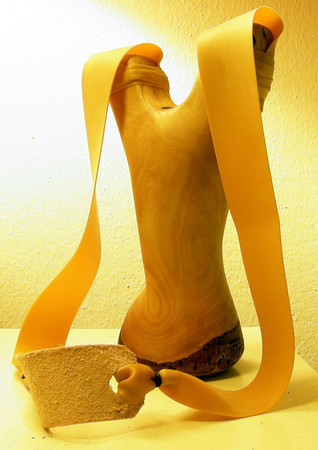
The rubber bands are a slingshot's soul. They store the energy, propel the projectile and define much of the slingshot's characteristics. The frame doesn't do much more than help you to hold the bands in place.
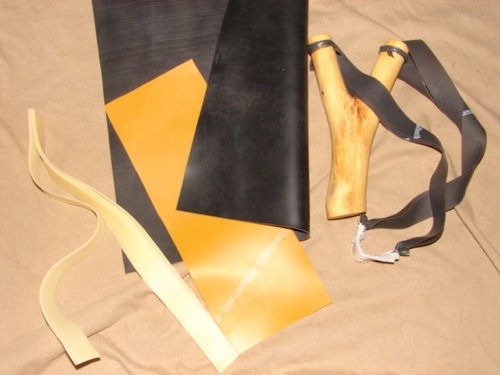
Switch to flatbands and you'll never look back. This sounds exaggerated, but is true with so many shooters! Flatbands are cut from thin (about 0.25-1mm) latex sheeting, and offer a number of unbeatable advantages: First, they have by far the highest performance. Second, it is easy to cut them exactly to the desired shape. A roll cutter is the best tool for this task. You can easily experiment with band length, width and tapering ratio until you have the perfect bandset for you. You can easily attach two or even three bands on each side of the slingshot - in fact, you often have to, as most types of latex sheeting are rather thin. Flatbands correspond very well to the "Over the top" attachmend method.
Disadvantage is the relatively low lifespan of flatbands. But you can easily exceed 2000 shots per set if you use thicker sheeting and keep the bands on the long side, with a tapering ratio of 2:3 or less.
Suitable latex sheeting is sold on various locations, usually for medical purposes and as exercise bands. The de-facto standard in the slingshot community is currently "Theraband" exercise sheeting. The strongest qualities (black, silver, gold) are usually regarded as the best choices for a good compromise between band life and performance.
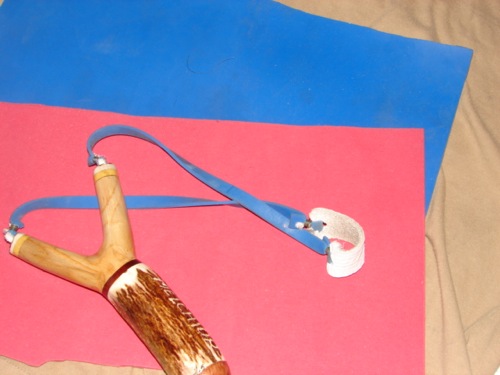
"Gum rubber" is the name that is chosen by slingshooters to describe natural rubber sheeting with a thickness of 1.5mm or more. It is used in the industry, to protect heavy machinery against abrasion. Most slingshooters prefer a thickness of 1.5-3mm, depending on the material and desired properties.
Gum rubber has a lower performance than flatbands. But "semi-flats", i.e. bands with 2mm or less, come quite close to them. And what's lost in performance is won in band life. They are also valued by collectors, as many vintage slingshots use some type of "gum rubber" bands, usually with approx. 2mm thickness. Gum rubber is perfect for a wide variety of attachment methods such as "Spain style" or the "matchstick method". This type of rubber is popular in many European slingshot associations.
However, be aware that Gum rubber has its drawbacks. It is very difficult to cut. You need a guillotine-style paper cutter for this job, and I recommend you not to purchase rubber with more than 2mm thickness. Talking about buying - this type of rubber is mainly sold for industrial purposes. You usually have large minimum orders. And be sure to pick the right material from the plethora of different rubbers! A well regarded type is "Linatex", which is used in quarry machinery and on shooting lanes to protect from ricochets.

Most shooters get in contact with tubular bands first. The reason is that the lion's share of commercially produced slingshots uses them. Not because the perform good - it's simply because they can be attached to pouch and frame by methods that don't require much human labor. Such tubes have high drawing weight and low power output! And the bigger the tubes, the worse gets its performance. It is also impossible to make tapered tubes at home. Very few shooters stay with large diameter tubular rubber when they have other alternatives.
Trumark sells tapered bands that are, performance-wise, in the region of untapered gum rubber. They are a viable alternative for those shooters who are not interested in crafting bandsets at home. The main sources for raw tubular rubber are exercise tubes (such as "Theratube", where the sizes "red" to "blue" are the most common choices) and surgical tubing. Always buy dipped, not extruded, latex tubing. The lifespan of big tubes can be high, but only if the attachment method doens't put much stress on them.
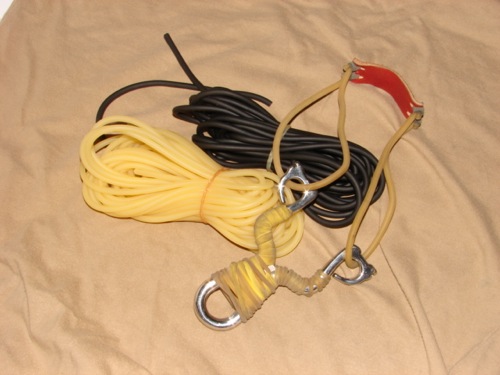
Tubular bands with small diameter are a different story than their big relatives. They perform still a good deal worse than flatbands, but are definitely usable - their performance is somewhere between tapered big-diameter tubes and tapered gum rubber. A typical china tube has an outer diameter between 40 and 50mm, and an inner diameter between 1 and 2mm. The Chinese shooter use these bands almost exclusively, just like the Western shooters turn towards flatbands.There are two main sources for china tubes: Theratube "amber" and chinese slingshot webshops and vendors.
China tubes have some intriquing advantages. First, they work very well with the traditional chinese attachment that you can see in the picture above. This attachment allows you to change the bands in seconds, and gives you a very clean sighting picture, as you can peek through the middle of the dual bands. Making a bandset from China tubes is also less cutting work. They generally have quite a long lifespan, and are the second most popular choice after flatbands.
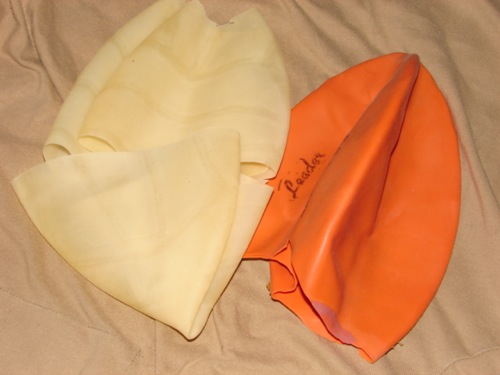
Did you ever wonder where the children in third world countries get their slingshot bands from? They take a busted soccer ball and cut the bladder out of it. All leather balls contain such a bladder, which is usually made of high quality dipped latex. Their thickness is about 0.75-1mm. It is difficult to cut good bandsets out of the round shape, but you will be rewarded with very well performing bands.
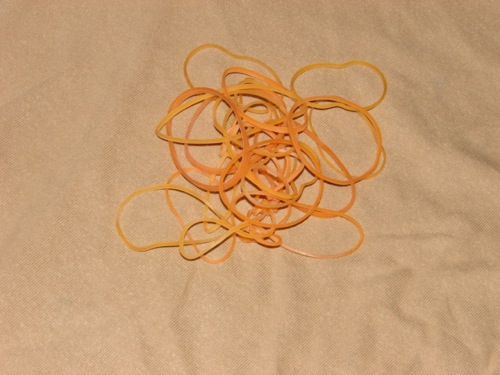
There are a lot of other sources for slingshot bands. Household rubber rings can be chained together to form a band. Make thise bands tapered by adding more rubber rings on one side, and you will have an excellent slingshot band. Only drawback is the very low lifespan of them, and the tedious work to replace broken rubber rings in such a band.
Condoms are dipped latex of extremely high quality. You could make a top-performing bandest out of them. But they are far too thin to have a usable lifespan. And it is not good for your reputation to walk around with a slingshot made of condoms.
A better source are heavy-duty latex gloves, as the ones that are worn by high-voltage electricians. You can cut flatbands out of them if you find a pair. Law dictates tat electricians have to change their gloves on a regular basis, so it is no harm to ask for old gloves if you see one in the streets.
Choosing good rubber material directly from the industry is a tedious thing. You have to invest a lot of time and money until you find an adequate quality. Don't do it unless you have no other source for rubber, or plan to buy large amounts for a club or the manufacturing of slingshots.
To date, every slingshot I am aware of uses bands that are made of natural rubber. Its source is the sap of the rubber tree, which is an emulsion called "latex". It can be transformed to a solid, elastic material by vulcanization. The result is natural rubber. Often, it is still called "latex", which can cause confusion among laymen.
I don't want to get into the details of the fascination manufacturing process of rubber. As a chemist, I encourage you to seek information about it if you are interested. But at this point, it suffices to know a few things about good slingshot bands: